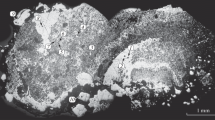Abstract
Native sulphur is encountered occasionally within the gypsiferous cap-rock of a Permian salt dome in the Hils syncline, in the environs of Weenzen (see map, Fig. 1). A number of sulphur isotope analysis demonstrated that the native sulphur originated out of the primary sulphates, had been depleted in34S, causing a relative enrichment of the remaining sulphate in34S. Those parts of gypsum which are entirely devoid of native sulphur, exhibit a34S value typical of Zechstein (upper Permian). The average enrichment of32S in native sulphur of about 26% suggests its bacteriological origin, since under the temperatures usually prevailing during the origin of a salt dome, a sulphate cannot be reduced by petroleum. During the rise of the salt dome, the sulphates became contaminated with a small amount of petroleum as a result of which a congenial ecological condition for the development of the sulphate reducing bacterias was produced. The34S depleted H2S, produced by these bacterial, reacted with the sulphate, thus giving rise to native sulphur (Feely andKulp, 1957).
The activity of the sulphate-reducing bacterial leads to different stages of fractionation in the different biochemical environments owing to the varying intensity of the bacterial growth, as well as to the variable ratios of reduced sulphate to primary sulphate. The highly mobile H2S was homogenized already before the precipitation of native sulphur, whereas the homogenisation of the sulphate is viewed in the solution and recrystallisation processes taking place just below the Neocomian transgression horizon.
Zusammenfassung
In der Hilsmulde tritt bei Weenzen ein Salzstock durch Kreide- und Tertiärsedimente zutage. Dieser Gips führt an einigen Stellen elementaren Schwefel. Durch Isotopenanalysen wurde festgestellt, daß der elementare Schwefel gegenüber dem Ausgangssulfat an34S verarmt und der Schwefelm Restsulfat entsprechend angereichert wurde. Schwefelfreie Bereiche des Gipses zeigen den für Zechsteinevaporite üblichen δ34S-Wert. Der Isotopenunterschied von durch-schnittlich 26% deutet auf bakteriellen Ursprung des Schwefels, weil eine anorganische Reduktion des Sulfates unter den vorauszusetzenden Temperaturen nicht möglich ist. Es wird angenommen, daß während des Aufstieges des Salzstockes ein geringfügiger Zutritt von Erdöl Lebensbedingungen für anaerobe Bakterien schuf, was zur Reduktion des Sulfats zu H2S führte. Der dabei freiwerdende Schwefelwasserstoff wurde durch Reaktion mit SO 2−4 in elementaren Schwefel umgewandelt. Da sich die Reduktion in den einzelnen Bereichen des Gipses sicher in Abhängigkeit von der Intensität der Bakterientätigkeit vollzog, hat sie primär wohl nicht zu homogener Verteilung der Schwefelisotope im Schwefelwasserstoff bzw. im Restsulfat geführt. Während für den elementaren Schwefel die nachträgliche Homogenisierung wegen der Beweglichkeit des Schwefelwasserstoffes verständlich ist, kann sie im Restsulfat so erklärt werden, daß dieses während der Neokomtransgression von oben her stärker der Lösung ausgesetzt war und umkristallisierte, wodurch sich die anfangs wahrscheinlich stärkeren Unterschiede in der Isotopenzusammensetzung des Gipses verwischten.
Similar content being viewed by others
Literatur
Deevey, E. S., N. Nakai, andM. Stuiver: Fractionation of sulfur and carbon isotopes in an Meromictic lake. Science139, 407–408 (1963).
Dessau, G., M. L. Jensen, andN. Nakai: Geology and isotopic studies of Sicilian sulfur deposits. Econ. Geol.57, 410–438 (1962).
Feely, H. W., P. W. Gast, andJ. L. Kulp: Häufigkeit von32S und34S in einigen natürlichen Schwefelvorkommen. Bull. Geol. Soc. Am.64, 1421 (1953).
——, andJ. L. Kulp: Origin of gulf coast salt-dome sulphur deposits. Bull. Am. Assoc. Petrol. Geologists41, 1802–1853 (1957).
Fratschner, W. T.: Facies und Tektonik im Hils. Diss. Clausthal 1950.
Gehlen, K. v., H. Nielsen u.W. Ricke: S-Isotopenverhältnisse in Baryt und Sulfiden aus hydrothermalen Gängen Südwestdeutschlands. Fortschr. Mineral.40, 71 (1962).
Goldmann, M. I.: Formation, metamorphism, and mineralization in gypsum-anhydrite cap-rock sulphur salt dome, Louisiana. Geol. Soc. Am. Memoir50 (1952).
Harrison, A. G., andH. G. Thode: The kinetic isotope effect in the chemical reduction of sulphate. Trans. Faraday Soc.53 (1957).
——, and ——: Sulphur isotope abundances in hydrocarbons and Source Rocks of Unita Basin, Utah. Bull. Am. Assoc. Petrol. Geologists42, 2642–2649 (1958).
Jensen, M. L., andN. Nakai: Biochemistry of sulfur isotopes. Geol. Soc. Am., Annual Meeting1960, 129 (1960).
Jones, G. E., andR. L. Starkey: Fractionation of stable isotopes of S by microorganisms and their role in deposition of native sulphur. Appl. Microbiol.5, 111–118 (1956).
— — Some necessary conditions for fractionation of sulphur isotopes by Desulfovibrio desulfuricans. Symposium 1962 (1962).
——, ——,H. W. Feely, andJ. L. Kulp: Biological origin of native sulfur in salt dome of Texas and Louisiana. Science123, 1124–1125 (1956).
Kaplan, I.: Sulfur cycle in recent marine muds. Symposium 1962.
Kaplan, I. A., T. A. Rafter, andJ. R. Hulston: S isotopic variations in nature. VIII. Application to some biochemical problems. New Zealand J. Sci.3, 338–361 (1960).
Lotte, F.: Steinsalz und Kalisalze. Teil I. Berlin 1957.
Macnamara, J., andH. G. Thode: The distribution of S34 in nature and the origin of native sulpfur deposits. Research4, 582–583 (1951).
Nakai, N., andM. L. Jensen: Biochemistry of sulfur isotopes. J. Earth Sci. Nagoya Univ.8, 181–196 (1960).
Nielsen, H., u.W. Ricke: Schwefel-Isotopenverhältnisse von Evaporiten aus Deutschland; ein Beitrag zur Kenntnis von34S im Meerwasser-Sulfat. Geochim. et Cosmochim. Acta28, 577–591 (1964).
Östlund, G. H., andJ. Alexander: Oxidation rate of sulfide in sea water. A preliminary study. J. Geophys. Research68, 3995–3997 (1963).
Ricke, W.: Präparation von Schwefeldioxid zur massenspektrometrischen Bestimmung des Schwefel-Isotopen-Verhältnisses32S/34S in natürlichen Schwefelverbindungen. Z. anal. Chem.199, 401–413 (1964).
Thode, H. G., A. G. Harrison, andJ. Monster: Sulfur-isotope fractionation in early diagenesis of recent sediments of northeast Venezuela. Bull. Am. Assoc. Petrol. Geologist44, 1809–1817 (1960).
Thode, H. G., H. Kleerekoper, andD. Mcelcheran: Isotope fractionation in the bacterial reduction of sulphate. Research4, 581 (1951).
Thode, H. G., J. Monster, andH. B. Dünnord: Sulphur isotope geochemistry. Geochim. et Cosmochim. Acta25, 159–174 (1961).
—,R. K. Wanlass, andR. Wallouch: The origin of native sulphur deposits from isotope fractionation studies. Geochim. et Cosmochim. Acta5, 286–298 (1954)
Author information
Authors and Affiliations
Rights and permissions
About this article
Cite this article
Schneider, A., Nielsen, H. Zur Genese des elementaren Schwefels im Gips von Weenzen (Hils). Beitr Mineral u Petrogr 11, 705–718 (1965). https://doi.org/10.1007/BF01128710
Received:
Issue Date:
DOI: https://doi.org/10.1007/BF01128710




